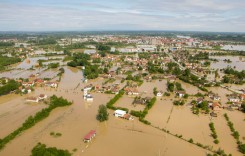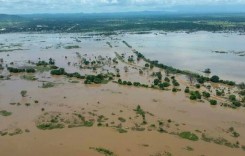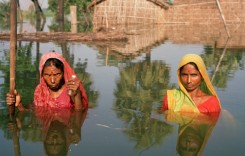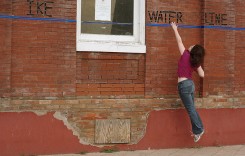Severe weather brought by storms and tropical cyclones Penny and Mona, has affected several Pacific islands over the last 2 weeks. At least 3 deaths have been reported with a further 6 people thought to be still missing.
Strong wind has damaged homes and crops, while heavy rain and storm surge has caused widespread flooding. Red Cross volunteers have been helping with evacuations and relief operations in the Solomon Islands, Fiji, the Marshall Islands and Kiribati. Flooding was also reported in parts of Papua New Guinea.
Meanwhile in Vanuatu, activity of the Yasur volcano is continuing and the Volcanic Alert Level remains at Level 2, according to the Vanuatu Meteorology and Geohazards Department.

Solomon Islands
Flooding has affected over 22,000 people in the Solomon Islands after days of heavy rain that began in late December.
Heavy rain was reported in parts of the islands from 27 December. During the following 3 days the weather station at Honiara / Henderson recorded a total of over 350mm of rain. More heavy rain – associated with Tropical Cyclone Penny – has fallen over the last few days. According to local reports, some areas have been flooded for 6 successive days.
Radio New Zealand said “The Solomons has been afflicted by heavy rain and strong winds for the last two weeks, which have caused rivers to bust their banks and sweep through villages on the main islands of Malaita and Guadalcanal.”
The Disaster Management Office said food supplies and health and sanitation packs were needed as the risk of water and mosquito borne diseases was rising.
Solomon Islands Broadcasting Corporation (SIBC), quoting National Emergency Operations Centre (NEOC) reported on 06 January that an estimated 23,708 people have been affected (4,480 households). NEOC said livelihoods and infrastructure have been affected in Guadalcanal, Isabel, Makira and Malaita. Evacuations have also been carried out in Honiara. Red Cross reported that around 200 homes were damaged in Malaita.
Local media reported 3 deaths as a result of the bad weather, in Isabel, Western, and Guadalcanal. Six people were also thought to be missing at sea in Makira-Ulawa and Western provinces.
Tropical Cyclone Penny Heads for Queensland
Tropical Cyclone Penny is continuing west over the Coral Sea towards the north-east coast of Queensland, Australia.
Australia’s Bureau of Meteorology said that Penny has weakened below cyclone strength and is approaching the Queensland coast as a low.
Bureau of Meteorology Weather Services Manager, Dr Richard Wardle, said there was still a moderate chance the low could re-intensify to cyclone strength, but the most likely scenario is that it will cross the coast as a low.
“Either way, heavy rainfall and damaging winds will be the main impacts,” he said.
“A severe weather warning is in place for coastal regions between Alva Beach and Sarina for damaging winds and heavy rainfall which may lead to flash flooding, particularly over the southern flank of the system.
“Heavy rain will initially develop around coastal regions from tomorrow (Tuesday) with isolated falls in excess of 200mm possible.
“Damaging winds with wind peak gusts of around 90 kilometres an hour may develop over the Whitsunday Islands as early as tonight.
“Ex-tropical Cyclone Penny is then forecast to move in a northerly direction along the Queensland coast during the week, bringing heavy falls northern coastal catchments which have already experienced recent heavy rain and may be more responsive.”
The Bureau has issued a new Flood Watch today for coastal catchments from St Lawrence to Cape Tribulation including the Mackay, Townsville and Cairns surrounding regions.
Papua New Guinea
Local media reported flooding in Jiwaka Province, Papua New Guinea, on 02 January and a period of heavy rain caused the Minj River in South Wagh to overflow.
The flooding has caused severe hardship for the local population after it damaged homes, destroyed food gardens and polluted water sources. No fatalities were reported.
Marshall Islands and Kiribati
A tropical storm on 02 to 04 January 2019 brought heavy rain and thunderstorms to parts of Kiribati and the Marshall Islands. Authorities warned of potential storm surges of over 3 metres.
There were some reports of flooding on the Kiribati islands of Tamana and Tarawa after storm surges and heavy rain. Bonriki on Tarawa atoll recorded 366.5 mm of rain in 72 hours to 04 January, 2019.
Red Cross said that teams are busy monitoring the impact of the floods in these remote areas, although as yet there are no exact figures for numbers affected.
Fiji
Preparations were underway in Fiji after Cyclone Mona threatened to cause devastation. Over 2,000 people were evacuated and several roads closed after minor flooding and landslides.
Around 06 January Cyclone Mona swerved east around the two main islands and Fiji escaped the worst. The storm is now weakening and, as of 08 January, was located approximately 150 km south-west of Ona Llau Island (Lau Islands, Fiji) and 480 km west of Tongatapu Island (Tonga).
As of 07 January, almost 600 people were still in shelters in 16 evacuations centres, in the Central, Northern, and Eastern Divisions. All evacuation centres are closed in the Western Division.
A tropical cyclone warning remains in effect for Ha’apai, Tongatapu and ‘Eua Islands (Tonga) and a strong wind warning for the southern Lau and Lomaivti Islands (Fiji).

Social Media
#SolomonIslands Red Cross volunteers are supporting communities across the islands hit by heavy rains, this family in Henderson lost their home. Red Cross volunteers are currently carrying out assessments in order to plan the relief operation. pic.twitter.com/7AmjJbbKZw
— Hanna Butler (@hannarosebutler) January 6, 2019
More photos coming in from #SolomonIslands Red Cross volunteers in Malaita province of the damage to homes following heavy rains, strong winds & flooding. pic.twitter.com/g9dj9IJa2i
— Hanna Butler (@hannarosebutler) January 4, 2019
#Vanuatu Red Cross teams are loading up relief items – tarpulins, shelter kits, kitchen sets & hygiene items for earthquake affected communities in #Ambrym.
Support also includes safe shelter training, health & hygiene activities & psychosocial support. pic.twitter.com/JhGp9QbVDE
— Hanna Butler (@hannarosebutler) January 3, 2019
Our friends in #Fiji and the #Pacific are on standby and working with communities in the path of #TCMona #CycloneMona to prepare them for the storm. #RedCross pic.twitter.com/yTNdUwefZy
— IFRC Asia Pacific (@IFRCAsiaPacific) January 3, 2019








